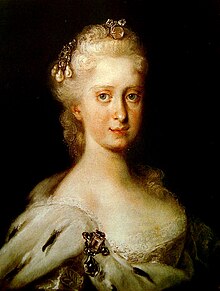Maria Josepha
| Maria Josepha of Austria | |
|---|---|
| Queen consort of Poland Grand Duchess consort of Lithuania Electress consort of Saxony |
|
 |
|
| Queen of Poland | |
| Tenure | 1734 – 17 November 1757 |
| Coronation | 17 January 1734 Wawel Cathedral, Kraków |
| Born | 8 December 1699 Hofburg Palace, Vienna, Austria |
| Died | 17 November 1757 (aged 57) Dresden, Saxony |
| Burial | Catholic Court Church, Dresden |
| Spouse | Augustus III of Poland |
| Issue More |
Frederick Christian, Elector of Saxony Maria Amalia, Queen of Spain Princess Maria Margaretha Maria Anna, Electress of Bavaria Prince Franz Xavier Maria Josepha, Dauphine of France Carl, Duke of Courland Maria Christina, Abbess of Remiremont Princess Maria Elisabeth Albert Casimir, Duke of Teschen Clemens Wenceslaus, Archbishop of Trier Maria Kunigunde, Abbess of Essen |
| House | Habsburg |
| Father | Joseph I, Holy Roman Emperor |
| Mother | Wilhelmina Amalia of Brunswick |
| Religion | Roman Catholicism |
Maria Josepha of Austria (Maria Josepha Benedikta Antonia Theresia Xaveria Philippine, Polish: Maria Józefa; 8 December 1699 – 17 November 1757) was born an Archduchess of Austria, and from 1711 to 1717 was heir presumptive to the Habsburg Empire. By her marriage to Augustus III of Poland she was the Electress of Saxony and Queen consort of the Polish-Lithuanian Commonwealth.
Maria Josepha was born in Vienna, an Archduchess of Austria as the eldest child of Joseph I, Holy Roman Emperor, and Princess Wilhelmina Amalia of Brunswick-Lüneburg. During the reign of her grandfather, Maria Josepha's father and uncle signed the Mutual Pact of Succession of 1703, which was issued by her grandfather, Emperor Leopold I, and effectively made Maria Josepha the heiress presumptive to her uncle, Emperor Charles VI; however, Charles VI's Pragmatic Sanction of 1713 annulled the earlier agreement and made his daughter Maria Theresa his successor instead of Maria Josepha.
A marriage between Maria Josepha and Frederick Augustus II, Elector of Saxony (1696–1763) had been suggested by Frederick's father, August II the Strong, since 1704. The fact that Maria Josepha was not allowed to marry a non-Catholic, however, prevented the marriage. When Augustus converted to Catholicism in 1712, the negotiations became serious. On 20 August 1719, Maria Josepha and Frederick Augustus married. Through this marriage between the Houses of Wettin and Habsburg, Frederick Augustus II's father, hoped to place Saxony in a better position should there arise a war of succession to the Austrian territories. The couple's eldest surviving son, Frederick Christian, eventually succeeded his father as Elector of Saxony. In Saxony, the couple lived at Dresden Castle. The marriage has been described as happy, and Augustus was apparently never unfaithful.
...
Wikipedia
